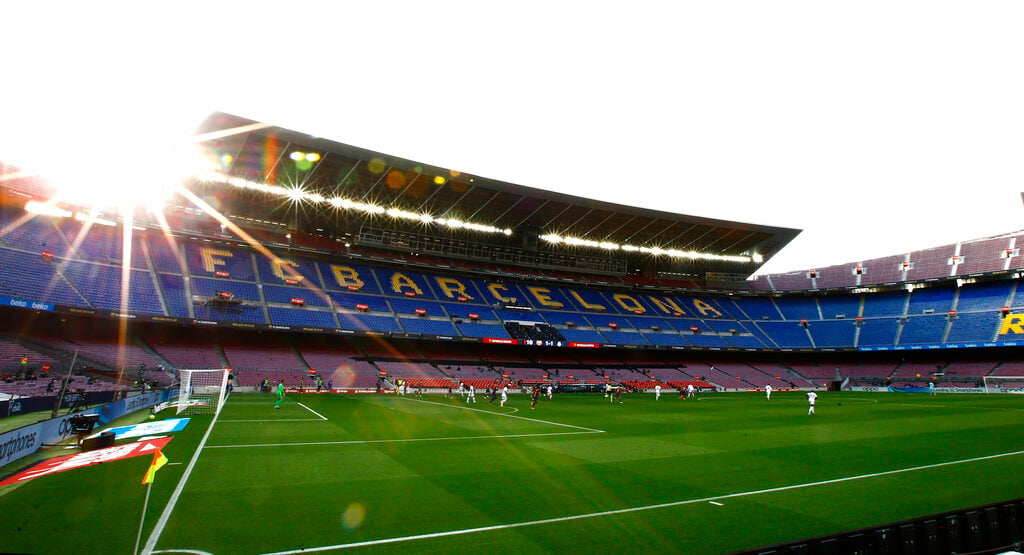As Barcelona’s iconic Camp Nou undergoes its most dramatic metamorphosis in history, we reveal exclusive insights into the revolutionary construction progress that’s reshaping football’s greatest theatre.
The Dawn of a New Era: Barcelona’s Stadium Revolution
Camp Nou, Barcelona’s legendary home since 1957, has embarked on its most ambitious transformation yet. The iconic stadium, which has hosted countless historic matches and witnessed Messi’s magic firsthand, is undergoing a comprehensive £1.5 billion renovation project. The necessity for this massive overhaul became apparent as the ageing structure, despite its grandeur, began showing signs of wear and structural concerns. Modern safety standards, coupled with Barcelona’s vision for a sustainable and technologically advanced stadium, drove this monumental decision. Currently, the construction site bustles with activity as Limak Construction, the Turkish firm heading the project, orchestrates a remarkable transformation. The project, which commenced in June 2023, has already achieved significant milestones, with excavation works progressing steadily and structural developments taking shape across various levels.
Breaking Ground: Current Construction Progress
- Extensive excavation work ongoing with fleet of trucks removing thousands of cubic metres of earth daily
- Installation of primary support structures and foundational elements nearing completion
- Assembly of elevator shafts and staircase sections progressing across multiple levels
- Concrete pumping operations standing by for next phase of structural work
- Integration of modern drainage and utility systems underway
Engineering Marvels: Key Structural Elements
The new Camp Nou’s structural design represents a triumph of modern engineering. The innovative stick beam system, a crucial component for enhanced stability, is being meticulously installed throughout the stadium. This revolutionary approach ensures superior load distribution and seismic resistance. The northern goal area has seen substantial reinforcement work, with advanced materials and techniques being employed to guarantee structural integrity. Perhaps most notably, the stadium’s crown jewel – its spectacular roof – is scheduled for installation in summer 2026. This architectural masterpiece will feature retractable elements and integrated solar panels, though its complexity has contributed to the extended timeline.
Premium Experience: The New Fan Journey
- Installation of premium recliner-style seating offering unprecedented comfort
- Development of state-of-the-art VIP boxes in upper-tier stands
- Enhanced hospitality areas with panoramic views of the pitch
- Modern concourse facilities with improved circulation space
- Digital integration throughout the stadium for an enhanced spectator experience
Timeline Challenges and Solutions
The ambitious project faces several timing considerations. Barcelona plans to return to their partially completed home for the 2025/2026 season, albeit without the iconic roof in place. Initial capacity will be significantly limited, with gradual increases as construction progresses. The club has requested permission for 24/7 construction operations to accelerate progress, demonstrating their commitment to minimising delays. Contingency plans include extending their stay at the Olympic Stadium in Montjuïc should the main structure not be ready for safe occupation. These challenges highlight the complex nature of renovating one of football’s most iconic venues whilst maintaining competitive operations.
The Bigger Picture: Impact and Future Implications
The new Camp Nou represents more than just a stadium renovation; it’s a statement of Barcelona’s vision for the future. The venue is being positioned as a strong contender to host the 2030 World Cup final, though competition from other prestigious venues remains fierce. Economically, the project is expected to generate significant revenue through enhanced commercial opportunities and increased tourism. The cultural impact cannot be understated, as the stadium continues to serve as a symbol of Catalan identity and footballing excellence. The sustainable design elements and technological innovations will set new standards for sporting venues worldwide.
Looking Ahead: What to Expect
- Final completion date set for 2028, with phased opening from 2025
- Ultimate capacity to exceed 105,000 spectators
- Sustainable features including solar panels and water recycling systems
- Advanced 5G connectivity throughout the stadium
- 360-degree screens and immersive fan experiences
- Improved accessibility and emergency evacuation systems
The new Camp Nou project represents an unprecedented undertaking in sporting architecture. While challenges remain, the vision of creating the world’s most advanced and sustainable football stadium drives this ambitious transformation forward. As construction progresses, football fans worldwide eagerly anticipate the unveiling of what promises to be an architectural marvel worthy of FC Barcelona’s illustrious heritage.
FAQ
What are the three largest stadiums in the world?
As of February 18, 2025, the three largest stadiums in the world by seating capacity are:
-
Narendra Modi Stadium: Located in Ahmedabad, India, this stadium has a seating capacity of 132,000 and is primarily used for cricket matches.
-
Rungrado 1st of May Stadium: Situated in Pyongyang, North Korea, it accommodates approximately 114,000 spectators and hosts various events, including football and athletics.
-
Michigan Stadium: Found in Ann Arbor, Michigan, USA, this stadium, known as “The Big House,” holds around 107,601 fans and is primarily used for American football.
It’s worth noting that Morocco has announced plans to construct the Grand Stade Hassan II near Casablanca, aiming for a capacity of 115,000. This stadium is projected to be completed by 2028 and could become the world’s second-largest stadium upon completion.
Additionally, Saudi Arabia is planning the King Salman International Stadium with a capacity of 92,760, intended to host the 2034 World Cup.
These developments indicate a trend toward constructing larger stadiums to host significant international events.
What is the most beautiful stadium in Europe 2024?
The Santiago Bernabéu stadium of Real Madrid has been awarded the title of Best Stadium in the World 2024 at the World Football Summit (WFS), the leading platform for the global football industry.
Which stadium has the highest capacity in Europe?
As of February 18, 2025, the largest stadium in Europe by seating capacity is Wembley Stadium in London, England, which can accommodate 90,000 spectators. This is due to the ongoing renovation of Camp Nou in Barcelona, Spain. Prior to its closure for refurbishment in June 2023, Camp Nou had a capacity of 99,354. The renovation aims to expand its capacity to approximately 105,000 seats, with completion expected by mid-2026.
How much does it cost to renovate Camp Nou?
As per the Daily Mail, Barcelona’s renovation of the Spotify Camp Nou cost the club £1.25 billion ($1.58bn).
Sources
[1] https://www.youtube.com/watch?v=bSZnma7hujA
[2] https://www.youtube.com/watch?v=6SUbj7tqcTQ
[3] https://stadiumdb.com/constructions/esp/camp_nou

